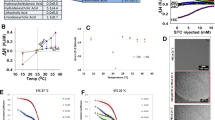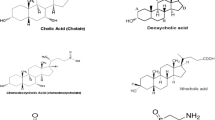Abstract
Purpose. The aqueous solubility and the extent of solubilization and ionization constant in sodium taurodeoxycholate (NaTDC) solutions of a series of benzoic acid and aniline derivatives were measured as a basis to characterize and thereby help predict the nature of the interaction of drugs with bile aggregates.
Methods. The aqueous solubility and the solubilization of two series of compounds, 4-alkyl benzoic acids and 4-alkyl anilines, was measured as a function of NaTDC in 0 and 150 mM NaCl. The ionization constants were determined in water and in 50 mM NaTDC at sodium chloride concentrations of 0, 75 and 150 mM by spectrophotometric titration. The diffusion coefficients of NaTDC and the solutes were measured by pulsed-field gradient spin echo NMR spectroscopy.
Results. The aqueous solubilities decreased with increasing alkyl chain length in both series, and the aniline derivatives had larger solubilities than the benzoic acid derivatives. The number of moles of solute solubilized per mole of bile salt ranged from 0.17 to 0.31 for the benzoic acid derivatives and from 1.3 to 3.0 for the aniline derivatives. The pKa values of the benzoic acid derivatives in the presence of NaTDC were higher relative to the controls, and the difference in the pKa (ΔpKa,obs) increased with increasing chain length. With the aniline derivatives, the pKa values were also shifted to higher values in NaTDC relative to the control but only in the absence of salt. The presence of the solute caused a decrease in the diffusion coefficient of NaTDC, and the diffusion coefficients of the solutes decreased with increasing alkyl chain length. With the hexyl derivatives, the diffusion coefficient of the solute was smaller than the diffusion coefficient of the bile salt. The chemical shift of the protons attached to carbon 18 and 19 of the bile salt were decreased to a greater extent in the presence of the solutes than the protons attached to carbon 26.
Conclusions. Both the solubilization and ionization behavior of solutes were affected by the presence of bile salt aggregates. The surface potential and effective polarity of NaTDC aggregates were found to be dependent on the alkyl chain length for these two homologous series of solutes. The solubilization ratio was largely independent of alkyl chain length, but the unitary partition coefficient was dependent on both the alkyl chain length as well as ionization state. The derivatives reduced the diffusivity of the micelles suggesting the formation of larger sized aggregates and the solutes (hexyl derivatives) appear to favor association with the larger sized aggregates. The phenyl ring of the solutes appears to be oriented parallel to the plane of the steroid frame with preferential positioning near the hydrophobic rings.
Similar content being viewed by others
REFERENCES
P. Tso. Adv. Lipid Res. 21:143–186, (1985).
W. N. Charman, C. J. H. Porter, S. Mithani, and J. B. Dressman. J. Pharm. Sci. 86:269–282 (1997).
V. Bakatselou, R. C. Oppenheim, and J. B. Dressman. Pharm. Res. 8:1461–1469 (1991).
S. D. Mithani, V. Bakatselou, C. N. TenHoor, and J. B. Dressman. Pharm. Res. 13:163–167 (1996).
L. J. Naylor, V. Bakatselou, and J. B. Dressman. Pharm. Res. 10:865–870 (1993).
C-Y. Li, C. L. Zimmerman, T. S. Wiedmann. Pharm. Res. 13:907–913 (1996).
X. Cai, D. J. W. Grant, and T. S. Wiedmann. J. Pharm. Sci. 86:372–377 (1996).
E. Kolehmainen. J. Coll. Interf. Sci. 105:273–277 (1985).
E. Kolehmainen. J. Coll. Interf. Sci. 127:301–309 (1989).
G. V. Shilnikov, A. P. Sarvazyan, M. Okon, J. Zakrzewska, J. Hranisavljevic, and D. Vucelic. J. Lipid Res. 28:1987–1994 (1987).
M. C. Carey, P. C. Hirom, and D. M. Small. Biochem. J. 153:519–531 (1976).
C.-H. Han. Ionization and solubilization behavior of retinoids in aqueous and bile salt micellar solutions. Doctoral Thesis, University of Minnesota, 1997.
M. A. Schwarz, R. H. H. Neubert, and G. Dongowski. Pharm. Res. 13:1174–1180 (1996).
M. S. Fernandez and P. Fromherz. J. Phys. Chem. 81:1755–1761 (1977).
C. J. Drummond, F. Grieser, and T. W. Healy. Faraday Disc. Chem. Soc. 81:95–106 (1986).
J. T. Rubino and W. S. Berryhill. Pharm. Res. 75:182–186 (1986).
H. S. Harned and B. B. Owen. In “The physical chemistry of electrolytic solutions,” Third Edition, American Chemical Society, Reinhold Publishing Corp, NY (1967).
P. Mukerjee and K. Banerjee. J. Phys. Chem. 68:3567–3573 (1964).
E. G. Rippie, D. J. Lamb, and P. W. Romig. J. Pharm. Sci. 53:1346–1348 (1964).
A. Albert and E. P. Serjeant. In “The Determination of Ionization Constants.” Chapman and Hall Ltd., New Fetter Lane, London, 1971, p 44–60.
P. Stilbs. Prog. Nucl. Magn. Reson. Spectrosc. 19:1–45 (1987).
B. Jonsson, H. Wennerstrom, P. G. Nilsson, and P. Linse. Coll. & Poly. Sci. 264:77–88 (1986).
C-Y. Li, C. Zimmerman, and T. S. Wiedmann. Pharm. Res. 13:535–541 (1996).
D. J. Cabral and D. M. Small. In “Handbook of physiology—The gastrointestinal system III. Section 6, S. G. Schultz, J. G. Forte, and B. B. Rauner (eds) Waverly Press: New York, 1989, pp. 621–662.
Merck Index, Eleventh Edition, Merck & Co.: Rahway, NJ, (1989).
A. Albert and E. P. Serjeant. In “The Determination of Ionization Constants,” Chapman and Hall Ltd., New Fetter Lane: London, 1971.
K. A. Connors. In “A Textbook of Pharmaceutical Analysis,” Second Edition, John Wiley & Sons: New York, 1975, pp. 131.
S. S. Davis, T. Higuchi, and J. H. Rytting. In “Advances in Pharmaceutical Sciences,” H. S. Bean, A. H. Beckett, J. E. Carless, (eds) Academic Press, NY., 1974, pp. 73–261.
S. W. Ayd and H. Alkan-Onyuksel. Pharm. Res. 12:S-145 (1995).
D. M. Small. Adv. Chem. Ser. 84:31–52 (1968).
S. Barnes. Hepatology 4:98S–103S (1984).
A. Coello, F. Meijide, E. R. Nunez, and J. V. Tato. J. Pharm. Sci. 85:9–15 (1996).
N. A. Mazer, M. C. Carey, R. F. Kwasnick, and G. B. Benedek. Biochemistry 18:3064–3075 (1979).
R. K. Harris. In “Nuclear Magnetic Resonance Spectroscopy,” Longman Scientific & Technical and John Wiley & Sons, Inc., New York, (1986).
Author information
Authors and Affiliations
Corresponding author
Rights and permissions
About this article
Cite this article
Wiedmann, T.S., Kvanbeck, K., Han, CH. et al. lonization and Solubilization of 4 Alkyl Benzole Acids and 4 Alkyl Anilines in Sodium Taurodeoxycholate Solutions. Pharm Res 14, 1574–1582 (1997). https://doi.org/10.1023/A:1012178318128
Issue Date:
DOI: https://doi.org/10.1023/A:1012178318128




